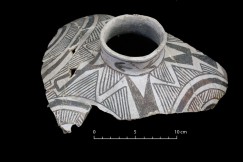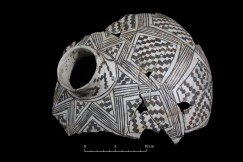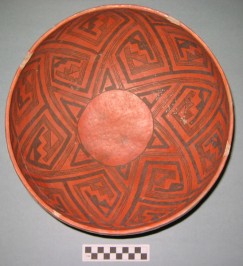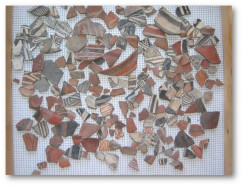- Home
- >
- Preservation Archaeology Blog
- >
- Learning from Pottery, Part 1: Dating
 |
By Deborah L. Huntley, Preservation Archaeologist
|

When an archaeologist says that a site was inhabited, say, during the late 1200s A.D., how does he or she know that? There are many methods used to date archaeological sites. Some, like radiocarbon dating of materials like burned wood or corn, measure the age of a sample directly and provide calendar dates. Unfortunately, not every site produces materials that can be dated in this way. In addition, radiocarbon dating often gives a date range with quite a large standard error, which may not be all that useful for certain time periods. Dendrochronology, or tree-ring dating, is one of the best tools available to Southwestern archaeologists, but it requires wood from certain tree species, such as oak or Ponderosa pine. If the residents of a particular village used different species for construction, or if wood beams were not preserved at a particular site, dendrochronology is probably not an option for site dating. This has been a problem in our research in the Mule Creek area; although we hold out hope for materials recovered during our 2011 excavations, none of the many samples that we have submitted for tree-ring dating have been datable thus far.

This is where pottery comes in, particularly decorated pottery—which, luckily, is common on many Southwestern sites after about A.D. 700. We know that many decorated pottery types were made and used during particular time periods in certain areas because they have been cross-dated; that is, archaeologists have found them regularly in excavated contexts that have been tree-ring dated. Some parts of the southwest, such as the Cibola region on the Colorado Plateau, have very precise ceramic chronologies. As such, archaeologists feel confident that they know the production dates (give or take 25 years) for various pottery types made in the Cibola region, and they can assign dates to sites based on their relative frequencies of decorated ceramic types.

Other areas, such as the Upper Gila region, have less securely defined ceramic chronologies, particularly for the 1150–1300 interval following the Mimbres Classic abandonment of the area. Part of the problem is that local populations appear to have been relatively small (at least compared to earlier and later time periods), and large numbers of decorated ceramics were not left behind at most sites. At Fornholt and elsewhere in the Upper Gila region, local people apparently made very little of their own decorated pottery. Another problem is that many of the thirteenth-century decorated types made in southern New Mexico have not been very well cross-dated and seem to have very long production spans, making their temporal resolution less useful for dating site occupations.
Despite these potential pitfalls, for the latest component of the Fornholt site—the two-story masonry pueblo—we have been able to use ceramic cross-dating to help pin down how long the pueblo was occupied and when it may have been abandoned. Varieties of non-local Cibola White Ware and White Mountain Red Ware have been particularly helpful. We know that Tularosa Black-on-white (Image 1), Pinedale Black-on-white (Image 2), and St. John’s Polychrome (Image 3) were made in the late 1200s to until about 1325 to the north and west of Fornholt (more about how we know this and what it means about long-distance connections is the subject of Learning from Pottery, Part 2). We have found sherds of these types in the fill of several different rooms at Fornholt, so we can deduce that the pueblo was occupied during the late 1200s and perhaps into the early 1300s.

Analysis of the pottery recovered during our 2011 excavations at Fornholt is ongoing, and this analysis will help us refine our interpretations of the site’s occupation dates. We are also comparing Fornholt’s ceramic assemblage with assemblages from the nearby Gamalstad and 3-Up sites, and we are finding some interesting contrasts. Stay tuned!
Explore the News
-
Join Today
Keep up with the latest discoveries in southwestern archaeology. Join today, and receive Archaeology Southwest Magazine, among other member benefits.
One thought on “Learning from Pottery, Part 1: Dating”
Comments are closed.